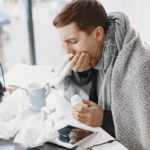
Understanding Silent Panic Attacks
Psychological distress is often accompanied by maladaptive behaviors and other physical signs. But in some cases, such as when someone is having a silent panic attack, you may have no idea that someone near you is in the midst of a crisis.
To learn more about Mental Health Treatment options at New Mind Wellness, call us today or verify your insurance online. We’re excited to help you start your personal recovery journey.
What Are Panic Attacks?
Panic attacks are characterized by the sudden onset of intense fear, along with a variety of other highly distressing physical and psychological symptoms.
In addition to fear, someone who is having panic attack may also experience:
- Feeling of impending doom
- Dizziness or lightheadedness
- Flushing sensation in your face and neck
- Excessive perspiration
- Nausea
- Heart palpitations
- Chest pain
- Difficulty catching your breath
- Feeling like you are being choked or smothered
- Tingling in your hands and feet
- Trembling and shakiness
- Depersonalization, or the sense that you have become detached from your thoughts, feelings, and/or body
- Derealization, which is the sense that the world around you has become somehow skewed, such as by being drained of color
Panic attacks are often, but not always, associated with anxiety disorders such as:
- Social anxiety disorder (social phobia)
- Agoraphobia
- Specific phobia
- Panic disorder
- Separation anxiety disorder
- Depression
- Posttraumatic stress disorder (PTSD)
- Obsessive-compulsive disorder (OCD)
Other potential causes include major life changes, overwhelming stress, substance use, and untreated trauma that doesn’t rise to the level of a PTSD diagnosis. Certain genetic variations may also increase a person’s risk.
What Is a Silent Panic Attack?
A silent panic attack can include many of the symptoms listed in the previous section, with the exception of those that are easily observable. This means that someone who is in the midst of a silent panic attack will not exhibit trembling, shakiness, excessive sweating, noticeable breathing problems, or flushing in the face.
As is also the case with standard panic attacks, the symptoms of silent panic attacks typically subside within about 10-20 minutes. However, the relative brevity of these symptoms doesn’t mean that they are easy to endure.
Even without external evidence of distress, silent panic attacks are still terrifying experiences that can cause a person to experience overwhelming fear, including the belief that they are having a heart attack and/or are about to die.

How Should You Respond to a Silent Panic Attack?
If you have a silent panic attack, helpful initial responses can include:
- Try to find a safe, comfortable place to sit down. If you are driving, pull into a parking lot or off to the side of the road and turn off the ignition.
- Remind yourself that this is a temporary experience and your symptoms will soon dissipate.
- If you are with someone, let them know what’s happening. If you are alone, call or text a close friend or trusted family member.
Once you are safe and seated, you can use a variety of grounding techniques to shift your focus away from your symptoms and direct your attention toward being fully in the present moment.
One option that has proved to be beneficial to many people is the 5-4-3-2-1 technique, which activates all five of your senses:
- 5 (Sight): Name five things you can see from where you are sitting. You may speak their names or note them silently – whichever feels right for you.
- 4 (Touch): Find four things in your immediate environment that you can touch. This may include something you’re wearing, an object in your possession, the grass, or what you’re currently sitting on.
- 3 (Hearing): Identify three sounds and their sources. Examples can include cars in the distance, people talking, and the wind rustling the leaves of a nearby tree.
- 2 (Smell): Note two things that you can smell. If you’re outside, this may include fresh flowers or recently cut grass. Other examples include cologne or perfume (yours or someone else’s), food being cooked, and scented soaps.
- 1 (Taste): What is one thing that you can currently taste? This can include the gum or mint you currently have in your mouth, or a residual taste from something you recently ate or drank.
Another way to ease the distress of a silent panic attack is to practice mindful breathing. This involves focusing your full attention on the sensation of slowly inhaling and exhaling. Here are two examples of what that can involve:
- Slowly inhale through your nose while silently counting to four. Hold your breath for a five count, then slowly exhale through your mouth for a count of six. Repeat this exercise until the symptoms of your silent panic attack begin to subside.
- Place your thumb on one side of your nose and a finger on the other side. Gently push your right nostril closed, then slowly inhale and exhale through your left nostril. Reverse the process by holding your left nostril closed and inhaling and exhaling through your right nostril. Repeat until you begin to feel better.
If you are with someone who tells you they are having a silent panic attack, you can apply many of the tips above in a slightly modified format:
- Help them find a safe comfortable space to sit down.
- Reassure them that they are safe, but do not minimize their distress or dismiss their concerns. When someone is having a silent panic attack, the physical and psychological pain they are experiencing are real.
- Encourage them to try the 5-4-3-2-1 technique or a mindful breathing exercise.
- Remain with them until their symptoms have subsided and they are no longer in crisis.
How Are Silent Panic Attacks Treated?
The best treatment for silent panic attacks can vary according to their cause. For example, if a person has a silent panic attack due to stress, the ideal approach may involve helping them develop more effective stress-management or problem-solving skills.
For someone who has been having silent panic attacks due to a mental or behavioral health concern, treatment may involve a combination of medication and therapy.
Depending on which type of disorder the individual has, they may benefit from prescription medications such as:
- Selective serotonin reuptake inhibitors (SSRIs)
- Serotonin-norepinephrine reuptake inhibitors (SNRIs)
- Benzodiazepines
- Tricyclic antidepressants
The therapeutic component of treatment, which will also be influenced by the type of mental health disorder the person has, can include:
- Individual, group, and family sessions
- Cognitive behavioral therapy (CBT)
- Dialectical behavior therapy (DBT)
- Eye movement desensitization and reprocessing (EMDR) therapy
- Meditation, yoga, tai chi, and other holistic therapies
- Red light therapy
- Genetic testing
Find Treatment for Panic Attacks in Philadelphia, PA
New Mind Wellness Center offers personalized outpatient treatment for adults who have been experiencing silent panic attacks and other mental health concerns.
The continuum of care at our outpatient center in Philadelphia, PA, includes a partial hospitalization program (PHP), an intensive outpatient program (IOP), and an outpatient program (OP). Our team will work closely with you to determine which levels of care and types of treatment best align with your needs and goals.
To learn more about how we can help you or a loved one, or to schedule a free consultation, please visit our Contact page or call us today.





